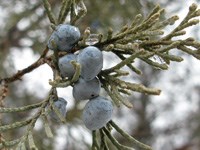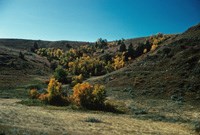
Nathan King, NPS Forests are not the dominant habitat type in Theodore Roosevelt National Park, but they form an important component of the park's habitat diversity. There are primarily two types of forests in the park: juniper woodlands and hardwood forests. Rocky Mountain juniper woodlands are the most common forest type in the park because the junipers benefit from a microclimate created on the north face of the buttes. There, the sun's heat is less intense and water evaporation is lower. Conversely, the south faces of the buttes are hotter and drier, and junipers are less common. Juniper woodlands on the north faces of buttes also slow the effect of erosion, and the north faces of the hills are not as steep as the south faces where junipers are not prevalent. Elk prefer juniper woodlands where they can escape the heat of summer and the cold winds of winter. The berries produced by junipers are a critical food source for birds including Townsend's solitaires, cedar waxwings, bohemian waxwings, and American robins. 
The dry climate of the North Dakota badlands limits the amount of hardwood forests. Hardwoods including green ash, American elm, box elder, and cottonwoods cling to the riverbottoms and draws where water is more available. These larger trees allow shrubby vegetation to grow beneath them, and the habitat favors some animals such as white-tailed deer, porcupines, and forest-dwelling birds. |
Last updated: April 10, 2015
